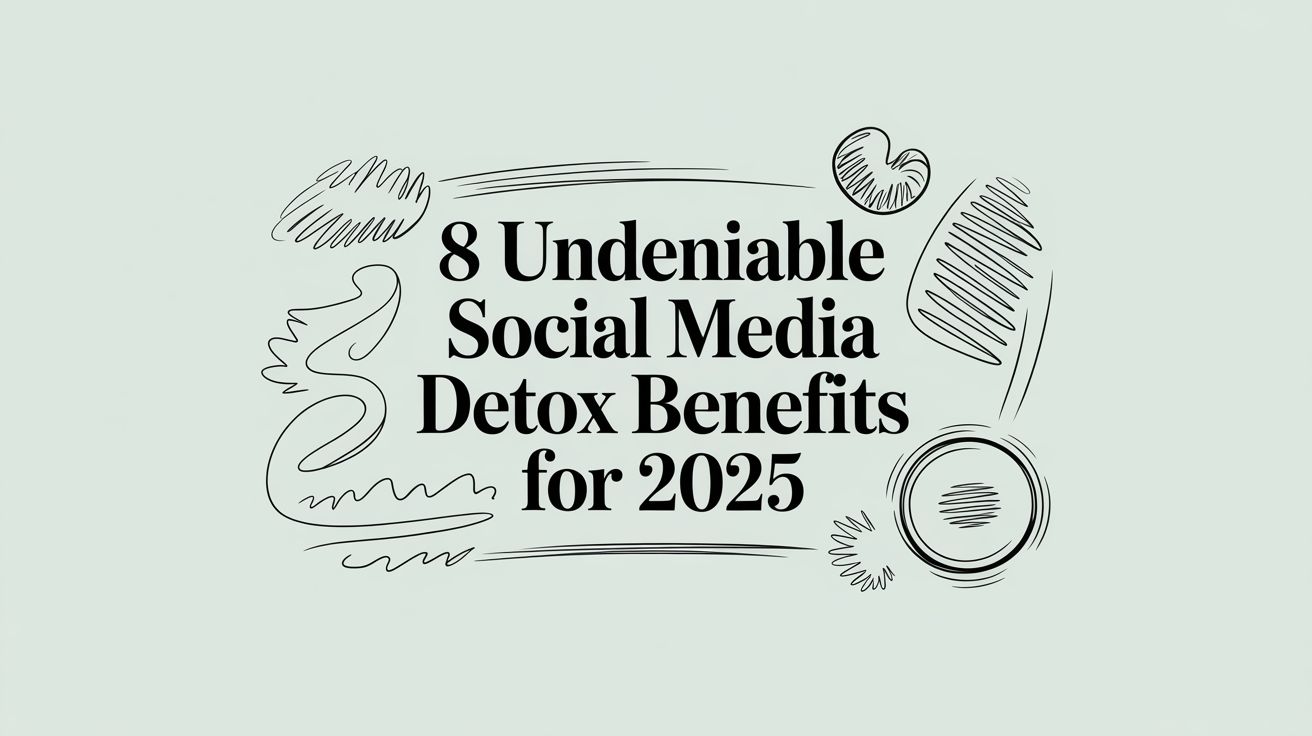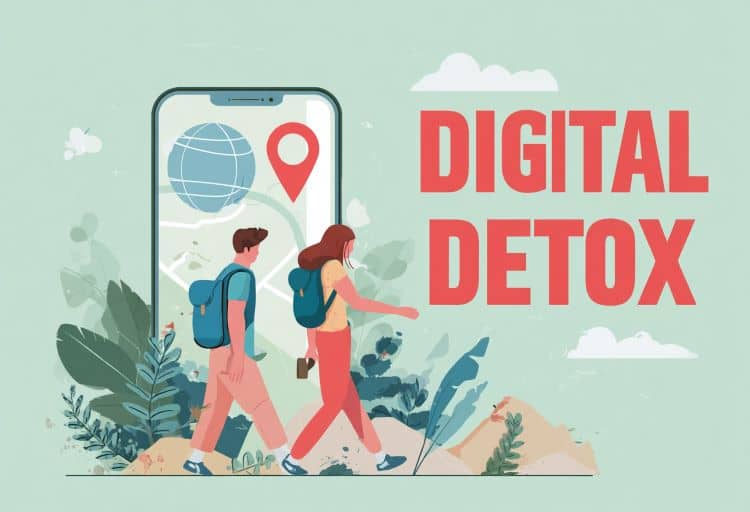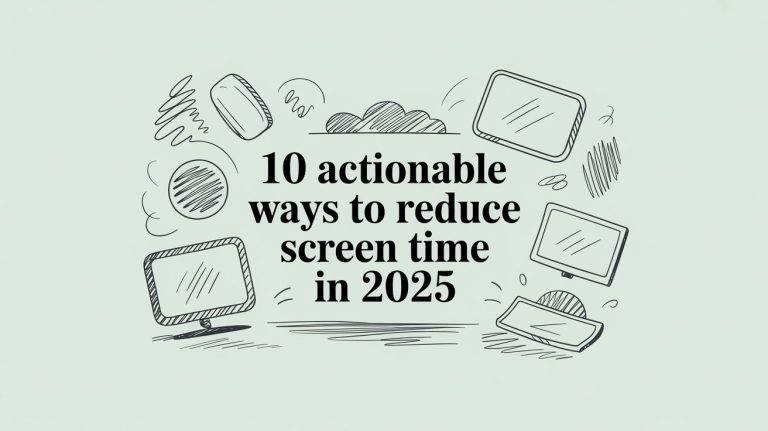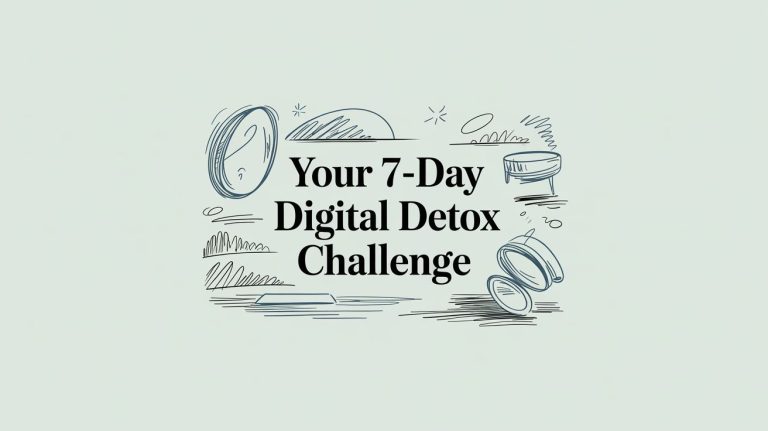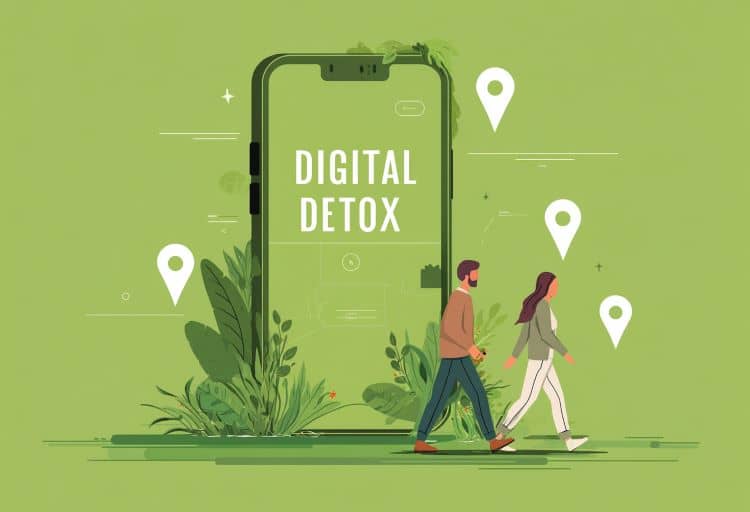8 Undeniable Social Media Detox Benefits for 2025
In a world saturated with notifications, likes, and endless scrolls, the idea of a social media detox can feel radical. Yet, the evidence is mounting: stepping back from digital noise is one of the most powerful actions you can take for your mental clarity, productivity, and overall well-being. The constant connection promised by these platforms often comes at a high cost, such as fragmented attention, heightened anxiety, and a skewed sense of reality. This is not about abandoning technology forever; it is about reclaiming control and using it intentionally.
This article provides a comprehensive breakdown of the most significant social media detox benefits, moving beyond generic advice to deliver actionable insights. We will explore eight evidence-backed advantages, from reducing anxiety and improving sleep to boosting creativity and strengthening real-world relationships. For each benefit, we will dissect the before-and-after dynamics, offering a clear comparison of life with and without constant digital interruption.
You will learn not just why unplugging matters, but how to implement these changes for a lasting impact. We will cover specific strategies, practical applications, and ways to manage the transition effectively. Prepare to delve into the tangible ways a temporary disconnect can lead to a more fulfilling and present life, supported by research and designed for immediate application. The goal is to equip you with a clear understanding of the implications of a digital reset and the tools needed to achieve it successfully. Let’s explore how a strategic pause can fundamentally improve your daily experience.
1. Improved Mental Health and Reduced Anxiety
One of the most immediate and profound social media detox benefits is the significant improvement in mental well-being. Constant exposure to algorithmically curated feeds, which often prioritize emotionally charged and comparison-inducing content, can create a high-stress digital environment. This relentless cycle of social comparison, fear of missing out (FOMO), and the pressure to maintain a perfect online persona directly contributes to heightened levels of anxiety and symptoms of depression.
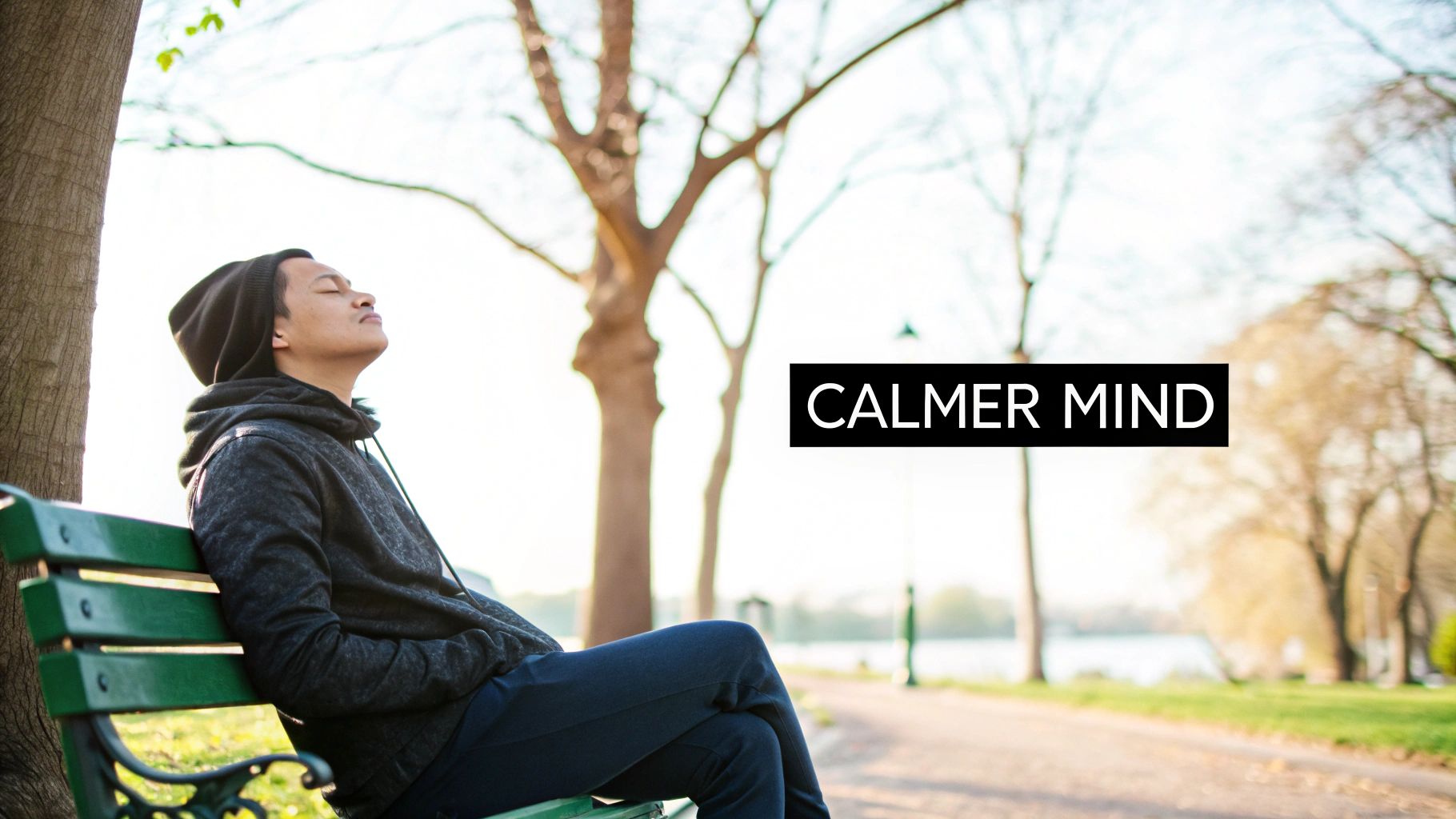
Taking a deliberate step back allows your brain to reset. Without the constant influx of notifications and digital “noise,” your nervous system can downregulate from a state of hyper-arousal. Research from social psychologists like Jonathan Haidt and Dr. Jean Twenge highlights the correlation between rising social media use and declining mental health, particularly among younger generations. A temporary or permanent break disrupts this pattern, giving you the mental space to process your own thoughts and emotions without external validation or comparison. Users often report feeling a palpable sense of relief and calm within just a few days.
Before vs. After: A Mental State Comparison
- Before (On Social Media): Your mental state is reactive. Moods can be dictated by the content you consume—a friend’s engagement announcement might trigger envy, while a negative comment can ruin an afternoon. Your brain is in a state of high alert, constantly processing social cues and seeking validation through likes and shares.
- After (During a Detox): Your mental state becomes proactive. You have the quiet mental space to process your own emotions without external triggers. Your self-worth becomes anchored in your internal values and real-world interactions, leading to a more stable and resilient emotional baseline. The constant, low-grade anxiety from FOMO dissipates.
Key Insight: A social media detox isn’t just about avoiding negativity; it’s about actively reclaiming your mental and emotional bandwidth from platforms designed to monopolize it.
Actionable Steps for Implementation:
- Start Small: Commit to a 3-day or 1-week detox to gauge its impact. This short timeframe makes the goal achievable and allows you to observe initial changes in your mood and anxiety levels.
- Track Your Mood: Use a simple journal or a mood-tracking app to log how you feel each day. Note your anxiety levels, overall happiness, and moments of stress. This creates tangible evidence of the detox’s benefits.
- Mindful Replacement: Intentionally replace the time you would have spent scrolling with a calming activity. Try a 10-minute guided meditation, journaling, or a short walk outdoors to actively soothe your nervous system.
- Set Boundaries: Inform close friends you’re taking a break so they know to contact you via text or a phone call. This prevents social anxiety about being perceived as unresponsive while managing expectations.
2. Enhanced Focus and Increased Productivity
Another critical social media detox benefit is the restoration of your ability to concentrate deeply. Social media platforms are meticulously engineered to fragment your attention. Features like infinite scroll, push notifications, and variable reward schedules (the unpredictable nature of likes and comments) train your brain to crave constant, small bursts of dopamine, making it difficult to sustain focus on complex, long-form tasks. A detox directly counteracts this by removing the source of constant interruption.
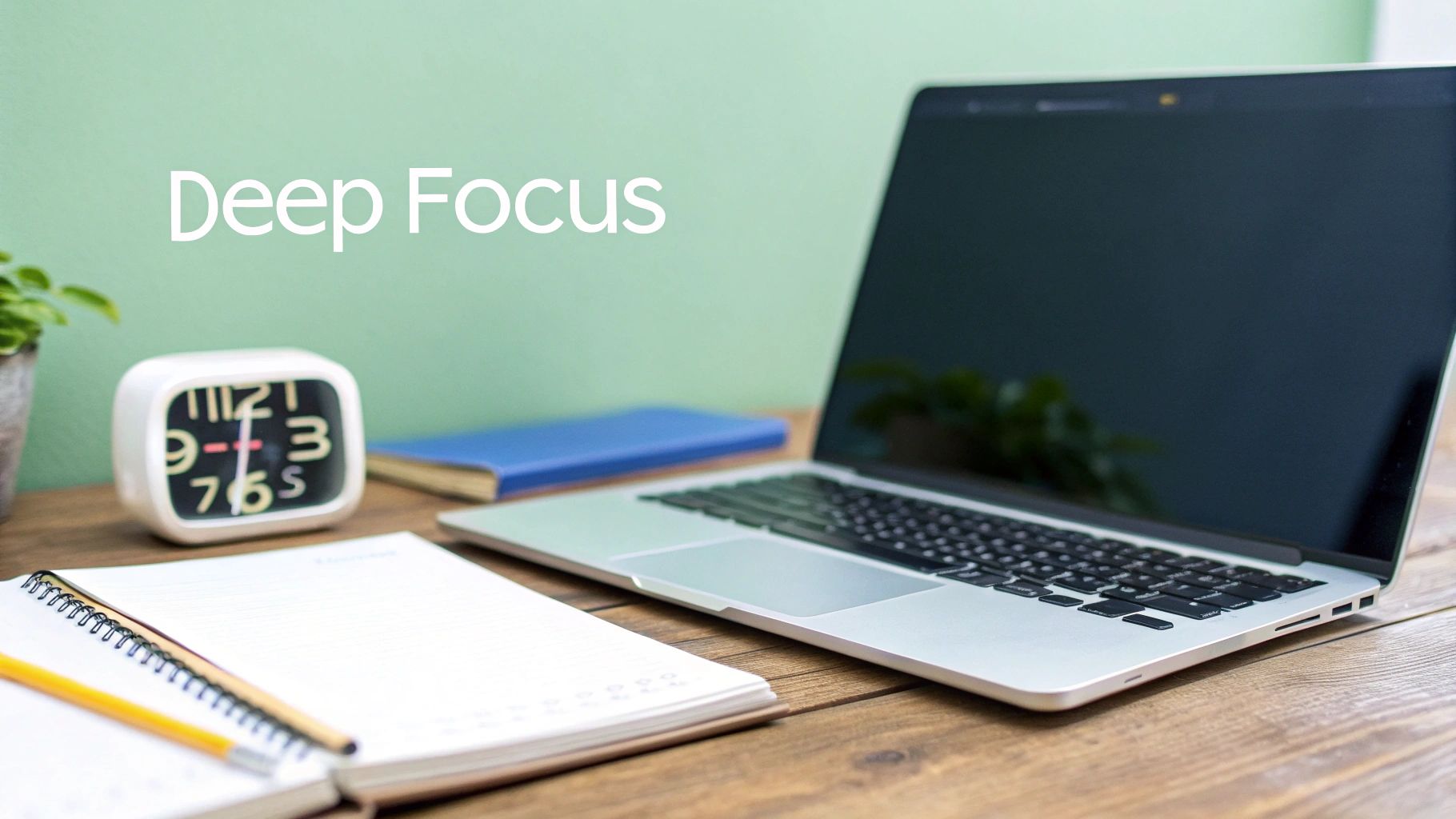
Stepping away allows you to rebuild your “attention muscles.” Without the constant pull of your phone, you can enter a state of deep work or “flow,” where you are fully immersed in a task and productivity soars. Thinkers like Cal Newport, author of Deep Work, argue that the ability to perform uninterrupted, focused work is becoming increasingly rare and valuable. A social media break is one of the most effective ways to cultivate this skill, enabling you to produce higher quality work, solve complex problems more efficiently, and feel a greater sense of accomplishment.
Before vs. After: A Productivity Comparison
- Before (On Social Media): Work is fragmented and shallow. You might switch between a report, your email, and a quick scroll through Instagram every 10-15 minutes. This “context switching” drains cognitive energy, leads to more errors, and extends the time required to complete tasks.
- After (During a Detox): Work becomes deep and efficient. You can dedicate large, uninterrupted blocks of time to a single task, achieving a state of flow. This leads to higher-quality output in less time, along with a greater sense of professional satisfaction and accomplishment.
Key Insight: True productivity isn’t about multitasking or being constantly connected; it’s about creating and protecting large, uninterrupted blocks of time for deep, focused effort.
Actionable Steps for Implementation:
- Schedule “Deep Work” Blocks: Use your calendar to block out 90-minute to 3-hour periods for focused work, free from all digital distractions. Treat these appointments with the same seriousness as a client meeting.
- Utilize the Pomodoro Technique: Work in focused 25-minute intervals, followed by a 5-minute break. This technique helps rebuild your concentration endurance by breaking down large tasks into manageable sprints.
- Create a Distraction-Free Zone: Designate a physical workspace where your phone is not allowed. Keeping your device in another room removes the temptation for impulse checking.
- Plan Your Break: A structured approach can make the process less daunting. For a complete guide on how to get started, you can follow a weekend digital detox step-by-step checklist.
3. Better Sleep Quality and Normalized Sleep Patterns
One of the most physically restorative social media detox benefits is the profound improvement in sleep. The late-night habit of scrolling through endless feeds disrupts our natural sleep-wake cycle in two critical ways: the blue light from screens suppresses melatonin production, the hormone that signals sleep, and the dopamine-driven content keeps our brains psychologically stimulated and alert. This combination of physiological and mental disruption leads to difficulty falling asleep, restless nights, and waking up feeling unrefreshed.
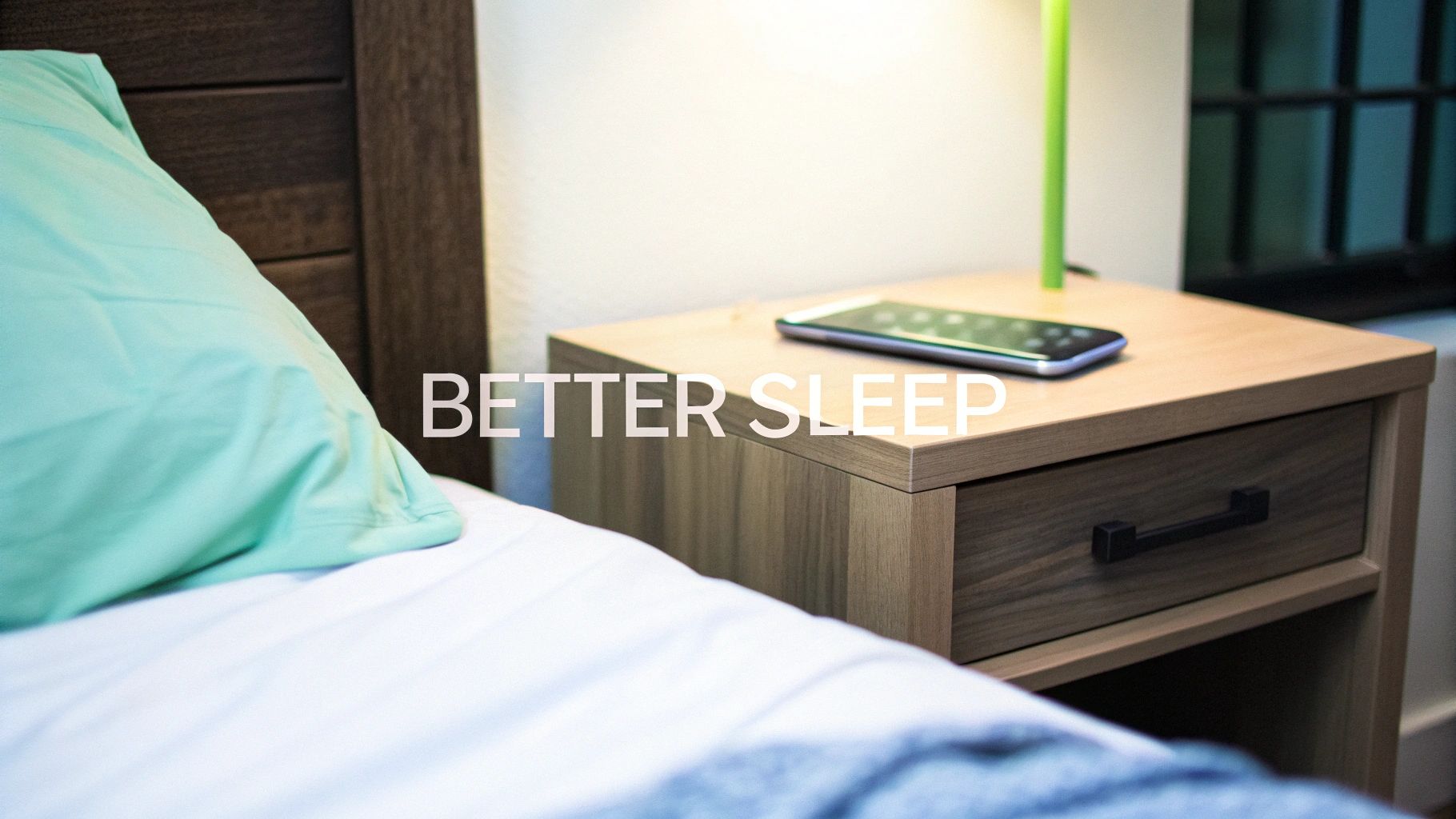
Taking a deliberate break from social media, especially in the hours before bed, allows your brain to naturally wind down. Without the melatonin-suppressing blue light and anxiety-inducing content, your circadian rhythm can normalize. Neuroscientist Matthew Walker, author of “Why We Sleep,” emphasizes that a consistent, screen-free pre-sleep routine is essential for high-quality rest. Studies have shown that simply removing smartphones from the bedroom can increase sleep quality significantly, leading to faster sleep onset and deeper, more restorative sleep stages.
Before vs. After: A Sleep Pattern Comparison
- Before (On Social Media): Your bedtime is inconsistent, often delayed by “just one more video.” Your brain is overstimulated right before trying to sleep, leading to a racing mind and difficulty winding down. You might wake up feeling groggy, as if you haven’t truly rested.
- After (During a Detox): You establish a consistent wind-down routine. Your brain receives clear signals that it’s time for rest, allowing for natural melatonin production. You fall asleep faster, experience deeper and more restorative sleep cycles, and wake up feeling genuinely refreshed and energized.
Key Insight: Better sleep isn’t just about avoiding blue light; it’s about giving your mind the quiet space it needs to transition from the day’s constant engagement to a state of deep, restorative rest.
Actionable Steps for Implementation:
- Establish a ‘Phone Sunset’: Designate a specific time, at least 60-90 minutes before bed, to put your phone away for the night. This creates a clear boundary between your active day and your rest period.
- Create a Screen-Free Wind-Down Routine: Replace scrolling with a calming, analog activity. Read a physical book, journal your thoughts, listen to calming music, or practice light stretching to signal to your body that it’s time to sleep.
- Charge Your Phone Elsewhere: Keep your phone and its charger in another room, like the kitchen or living room. This removes the temptation to check it “one last time” from your bed and prevents morning scrolling from being your first activity.
- Invest in an Analog Alarm Clock: Use a traditional alarm clock to avoid relying on your phone. This simple change eliminates a major excuse for keeping your device on the nightstand.
4. Increased Self-Esteem and Reduced Comparison Syndrome
Social media platforms are fundamentally highlight reels, presenting carefully curated and often idealized versions of reality. This constant stream of perfect vacations, career milestones, and flawless appearances creates a distorted social landscape, triggering a phenomenon known as “comparison syndrome,” where we measure our ordinary lives against others’ extraordinary moments. This cycle of upward social comparison can erode self-esteem and foster feelings of inadequacy.
Taking a break from these platforms removes the artificial benchmark. When you aren’t constantly exposed to polished online personas, you can begin to evaluate your life and accomplishments on your own terms. Research powerfully supports this, with a notable University of Pennsylvania study finding that reducing social media use to just 30 minutes per day led to significant decreases in loneliness and depression. Similarly, leaked internal research from Instagram confirmed the platform’s negative impact on the body image of teen girls, a direct consequence of relentless social comparison.
Before vs. After: A Self-Perception Comparison
- Before (On Social Media): Your self-worth is externalized and fragile. It can rise and fall based on likes, follower counts, and how your life appears to stack up against others’ online personas. You are constantly measuring yourself against an unrealistic, algorithmically-curated standard.
- After (During a Detox): Your self-worth becomes internalized and stable. You begin to appreciate your own journey, accomplishments, and circumstances without the distorting lens of social media. You build genuine confidence based on your actions, skills, and character, not on external validation.
Key Insight: Detoxing from social media doesn’t just silence the external noise; it quiets the internalized critic that constantly measures your worth against an impossible, algorithm-driven standard of perfection.
Actionable Steps for Implementation:
- Curate a Positive Offline Environment: Intentionally spend time with people who validate your intrinsic qualities, not your online presence. This reinforces your value outside of social metrics.
- Journal for Self-Validation: Keep a daily log of achievements, no matter how small, that are unrelated to your appearance or social status. Focus on skills learned, challenges overcome, or acts of kindness.
- Practice Competence-Building Hobbies: Engage in activities that build tangible skills, such as learning a musical instrument, gardening, or coding. Mastery in an offline skill provides a powerful and authentic source of self-esteem.
- Implement Positive Self-Talk: Actively catch and reframe negative, comparative thoughts. When you find yourself thinking, “My life isn’t as exciting as theirs,” consciously pivot to, “I am grateful for these specific things in my own life.”
5. Improved Real-World Relationships and Social Connection
While social media platforms are designed to connect us, they often foster shallow, passive interactions that can weaken our real-world bonds. The constant distraction of notifications and the pressure to maintain an online presence can pull our attention away from the people right in front of us, leading to what MIT researcher Sherry Turkle calls being “alone together.” One of the most rewarding social media detox benefits is the opportunity to reinvest that reclaimed time and energy into nurturing authentic, face-to-face connections.
Taking a break from digital platforms frees you from the performance of social connection and allows you to practice the art of genuine conversation and presence. Communication expert Celeste Headlee’s work emphasizes that true connection requires our undivided attention, something that is nearly impossible when a device is constantly vying for it. By removing the digital intermediary, you can engage more deeply, listen more actively, and build stronger, more resilient relationships with family, friends, and colleagues.
Before vs. After: A Social Connection Comparison
- Before (On Social Media): Connections are broad but shallow. You may have hundreds of “friends” but feel disconnected. Interactions are often passive (a quick “like”) or performative (posting for an audience). Your attention is divided, even when you’re physically with loved ones.
- After (During a Detox): Connections are deeper and more meaningful. You invest your time and energy in a smaller circle of key relationships. Conversations become more engaging because you are fully present. You trade the quantity of online followers for the quality of real-world bonds.
Key Insight: Real connection happens in moments of undivided attention. A social media detox creates the space for these moments to occur by removing the primary source of modern distraction.
Actionable Steps for Implementation:
- Schedule Phone-Free Time: Designate specific times, like dinners or weekend mornings, as device-free zones. This creates a ritual around being present with loved ones and encourages deeper conversation.
- Practice Active Listening: When you’re with someone, put your phone away and out of sight. Make eye contact, ask follow-up questions, and focus entirely on what they are saying without formulating your next response.
- Initiate Offline Activities: Instead of suggesting a group chat, organize a game night, a walk in the park, or a coffee meetup. Be the catalyst for in-person gatherings to rebuild connection habits.
- Inform Your Inner Circle: Let close friends know you’re taking a break and prefer to connect via a call or in person. This manages expectations and reinforces your commitment to more meaningful interaction.
6. Greater Creative Thinking and Innovation
The endless scroll of algorithmically curated content on social media often acts as a creative suppressant. Instead of allowing our minds to wander, we fill every spare moment with external stimuli, consuming ideas rather than generating our own. This constant influx of information leaves little room for the boredom and unstructured thought that are essential for true creativity and innovation to flourish.
Taking a break from social platforms creates the mental space necessary for your brain to make novel connections. Research, popularized by figures like Manoush Zomorodi in her work on boredom, shows that when our minds are under-stimulated, they activate the “default mode network.” This is the brain state linked to imagination, daydreaming, and connecting disparate ideas. By stepping away from the feed, you allow this natural creative engine to turn on, paving the way for breakthrough insights and original solutions that are often impossible to access amidst digital noise.
Before vs. After: A Creative Process Comparison
- Before (On Social Media): Your creativity is driven by consumption and trends. You might find inspiration by mimicking styles you see online, but your original thoughts are crowded out by the constant noise. Ideas feel derivative because your mental inputs are homogenized by algorithms.
- After (During a Detox): Your creativity becomes driven by introspection and observation. Boredom allows your mind to make unique connections between seemingly unrelated concepts. You start generating genuinely original ideas that reflect your unique perspective, rather than echoing online trends.
Key Insight: Creativity isn’t about finding inspiration on a screen; it’s about creating the mental quiet necessary for your own ideas to be heard. A social media detox provides that quiet.
Actionable Steps for Implementation:
- Embrace “Productive Boredom”: Instead of reaching for your phone in a queue or during a commercial break, just let your mind wander. Observe your surroundings and allow thoughts to flow without a specific goal.
- Carry an Idea Capture Tool: Keep a small physical notebook or use a simple notes app (on a device with social media apps blocked or deleted) to quickly jot down ideas that surface during your unplugged time.
- Engage in Analog Activities: Stimulate your brain in non-digital ways. Visit an art gallery, listen to an entire album without distractions, take a walk in nature, or work on a puzzle to engage different sensory and cognitive pathways.
- Schedule Unstructured “Think Time”: Deliberately block out 15-30 minutes in your calendar for doing nothing but thinking. Treat this as a crucial meeting with yourself to incubate ideas and solve problems without digital input.
7. Reclaimed Time for Meaningful Activities and Personal Goals
One of the most tangible and empowering social media detox benefits is the massive reclamation of your most finite resource: time. The average person spends hours each day scrolling through feeds, which accumulates into a staggering amount of time over a year. This passive consumption often displaces active pursuits that contribute to personal growth, skill development, and genuine fulfillment. A detox effectively returns this lost time to you.
Breaking away from platforms designed to maximize your “time on site” allows you to consciously redirect your attention toward long-neglected goals. As author Cal Newport explains in Digital Minimalism, this isn’t about shunning technology but about being intentional with it. When you remove the default option of scrolling, you create a vacuum that you can deliberately fill with high-value activities, whether it’s learning a new language, launching a side project, or committing to a fitness regimen. Many who take this step are shocked to discover just how much they can accomplish when their hours are not fragmented by constant digital interruptions.
Before vs. After: A Time Allocation Comparison
- Before (On Social Media): Your free time is passively consumed. Hours disappear into an endless scroll without you realizing it. Long-term goals like “learn to play guitar” or “write a book” remain perpetually on the back burner because small pockets of time are consistently lost to your phone.
- After (During a Detox): Your free time is actively invested. You suddenly have hours back in your day to dedicate to hobbies, exercise, learning, and personal projects. You move from being a consumer of content to a creator of your own life experiences, making tangible progress on your most important goals.
Key Insight: A social media detox is a powerful time-management strategy. It’s not about finding more time; it’s about recovering the significant portion of it you’ve unknowingly been giving away.
Actionable Steps for Implementation:
- Calculate Your Time Investment: Use your phone’s screen time report to calculate your daily social media usage. Multiply it by 365 to visualize the annual time cost. This stark number serves as a powerful motivator.
- Create a “To-Do” Wish List: Before you start your detox, list three to five goals or hobbies you’ve always wanted to pursue but “never had time for.” This gives you a clear and exciting purpose for your newfound hours.
- Schedule Your Goals: Treat your personal goals with the same importance as a work meeting. Block out specific times in your calendar for these activities, such as “Language practice: 7:00 PM – 7:30 PM.”
- Start with a Structured Plan: Don’t leave your free time to chance. A structured approach, like following a two-day digital detox checklist, can provide the framework needed to build momentum and successfully reallocate your time.
8. Reduced Problematic Behaviors and Healthier Decision-Making
Social media platforms are meticulously engineered to exploit human psychological vulnerabilities, promoting compulsive behaviors that often run counter to our best interests. The algorithmic design, built on principles like variable rewards and infinite scroll, encourages impulsive checking, reactive emotional responses, and even ill-advised purchases. Detoxing from this environment is one of the key social media detox benefits as it disrupts these ingrained behavioral loops, allowing your brain’s executive function to regain control and foster more intentional, values-aligned choices.
Taking a break restores your capacity for rational thought by reducing exposure to triggers designed to bypass it. Thinkers like Tristan Harris, a former Google design ethicist, have extensively documented how these platforms operate within an “attention economy,” hijacking our cognitive processes for profit. When you step away, you are no longer a passive participant in this system. Users frequently report a significant reduction in unnecessary online shopping and a decreased susceptibility to misinformation, as the space created by the detox allows for more critical thinking and less emotional reactivity.
Before vs. After: A Decision-Making Comparison
- Before (On Social Media): Your choices are heavily influenced and reactive. You might make an impulse purchase because of a targeted ad, form an opinion based on an emotionally charged headline without reading the article, or get drawn into a pointless online argument.
- After (During a Detox): Your choices become intentional and proactive. With a calmer mind, you have the cognitive space to evaluate decisions based on your own values and needs. You become less susceptible to marketing and propaganda, leading to better financial habits and more considered opinions.
Key Insight: A social media detox empowers you to break free from manipulative design patterns, transitioning you from a consumer driven by algorithms to an individual guided by conscious choice.
Actionable Steps for Implementation:
- Understand Addictive Design: Educate yourself on the psychological manipulation techniques used by platforms, such as intermittent variable rewards (like unpredictable notifications). Recognizing these tactics is the first step to neutralizing their power over you.
- Track Your Decisions: Keep a log of your spending habits and major decisions during your detox. Compare it to your pre-detox behavior to see tangible evidence of more mindful and intentional choices, reinforcing the benefits.
- Practice Delayed Gratification: When you feel the urge to buy something you saw online or react to a post, impose a 24-hour waiting period. This simple exercise builds the mental muscle for more thoughtful decision-making instead of impulsive action.
- Use Accountability Tools: When you decide to return to social media, use app blockers or set firm time limits. Share your goals with an accountability partner who can help you stick to your new, healthier boundaries.
Social Media Detox: 8-Benefit Comparison
| Item | Implementation Complexity 🔄 | Resource Requirements ⚡ | Expected Outcomes 📊 | Ideal Use Cases 💡 | Key Advantages ⭐ |
|---|---|---|---|---|---|
| Improved Mental Health and Reduced Anxiety | Medium — behavior change, may need gradual approach | Low–Moderate — time, possible clinician support | Clinically documented reductions in anxiety/depression (e.g., ~40% in 2–4 wks) | People with anxiety, high FOMO, teens | Lower cortisol, more stable mood, less rumination |
| Enhanced Focus and Increased Productivity | Medium — habit formation and environment changes | Low — app blockers, scheduling, dedicated workspace | 25–40% productivity gains; longer uninterrupted flow periods | Knowledge workers, students, professionals requiring deep work | Restored sustained attention; higher-quality output |
| Better Sleep Quality and Normalized Sleep Patterns | Low–Medium — establish new evening routines | Low — device rules (phone sunset), minimal tools | 30–60 min faster sleep onset; increased REM/deep sleep | Poor sleepers, shift workers, those using devices at night | Deeper restorative sleep; improved morning alertness |
| Increased Self-Esteem and Reduced Comparison Syndrome | Medium — psychological adjustment and reflection | Low — journaling, boundary-setting, possible therapy | Reports of large gains in body-image satisfaction (e.g., ~50% after 1 mo) | Adolescents, users affected by appearance/comparison issues | Reduced social comparison; more authentic self-worth |
| Improved Real-World Relationships and Social Connection | Low–Medium — schedule offline time, practice skills | Low — time and intentional rituals | Higher-quality interactions; stronger emotional intimacy | Families, couples, teams wanting deeper connection | More presence in-person; improved conversational depth |
| Greater Creative Thinking and Innovation | Low–Medium — allow unstructured/idle time | Low — notebooks, quiet spaces, intentional boredom | Increased original ideation and synthesis; better creative output | Creatives, R&D teams, anyone needing novel ideas | Restored default-mode activity; more novel connections |
| Reclaimed Time for Meaningful Activities and Personal Goals | Medium — intentional planning to repurpose time | Low–Moderate — planning tools, schedules, accountability | Recovery of 2–4+ hours/day; more progress on goals and hobbies | People pursuing learning, side projects, fitness | Large time recovery; focused pursuit of personal values |
| Reduced Problematic Behaviors and Healthier Decision-Making | High — breaking addictive patterns often requires support | Moderate–High — blockers, accountability, education | Reduced impulsive purchases (30–50% reported); better critical thinking | Individuals with compulsive checking/shopping or misinformation risk | Restored impulse control; decreased susceptibility to manipulation |
From Detox to Digital Balance: Your Path Forward
Embarking on a social media detox is not an end goal; it is a powerful catalyst for profound, sustainable change. As we’ve explored, the journey away from constant connectivity delivers a cascade of benefits that ripple through every aspect of your life. It’s a strategic reset, not a permanent retreat, designed to recalibrate your relationship with the digital world. The evidence is clear: stepping back allows you to step forward into a more focused, present, and fulfilling existence.
The core takeaway is that the incredible social media detox benefits you’ve read about, from reclaiming your mental health to boosting your creative output, are not isolated perks. They are interconnected components of a larger system of well-being. Improved sleep quality directly fuels your productivity. Enhanced real-world relationships combat the loneliness that comparison culture breeds. Reclaimed time gives you the space to pursue goals that build genuine self-esteem. This isn’t about demonizing technology; it’s about reclaiming your autonomy over it.
From Temporary Break to Lasting Transformation
The true value of a detox emerges when you transition from a temporary pause to a new, intentional equilibrium. The insights gained during your break are the building blocks for a healthier digital life. The initial discomfort of disconnection often reveals your deepest dependencies and triggers, providing a clear roadmap for what needs to change.
Think of it this way: a crash diet might lead to temporary weight loss, but it doesn’t teach you sustainable nutrition. Similarly, a one-off detox is a great start, but the real victory lies in integrating mindful tech habits into your daily routine. This is where the practical, actionable strategies discussed for each benefit become crucial.
Your path forward involves three key stages:
- Reflection: Identify which benefits resonated most. Was it the desire for deeper focus that stood out? Or the need to escape the anxiety loop? Pinpointing your primary motivation gives your efforts a powerful “why.”
- Implementation: Start small. You don’t need to overhaul everything at once. Choose one or two actionable insights from this article. Maybe it’s establishing a “no-phone” rule for the first hour of your day to boost productivity or scheduling one screen-free activity with a loved one each week to strengthen relationships.
- Reinforcement: Use tools to support your new habits. Willpower is a finite resource. Just as a professional uses specific software to manage their work, you can use specialized tools like the Digital Detox App to manage your digital well-being, set boundaries, and track your progress.
The True Prize: Reclaiming Your Attention
Ultimately, the most significant of all social media detox benefits is the reclamation of your attention. In an economy that mines our focus for profit, your attention is your most valuable asset. It is the currency of creativity, the foundation of meaningful relationships, and the engine of personal growth. When you are no longer fragmenting your focus across endless feeds and notifications, you unlock the cognitive resources needed for deep thought, innovative problem-solving, and genuine presence in your own life.
This journey from detox to balance is an act of empowerment. It’s about consciously deciding where you invest your time and energy, shifting from a reactive state driven by algorithms to a proactive one guided by your values and goals. The silence you cultivate by logging off is not empty; it is filled with opportunity, clarity, and the space to hear your own thoughts again. You are not just putting down your phone; you are picking up your life.
Ready to move from theory to action and experience these transformative social media detox benefits for yourself? The Digital Detox App provides the structured support you need to build lasting habits, with tools designed to help you set custom screen-time limits, schedule offline focus blocks, and create a personalized plan for sustainable digital balance. Take the first step toward reclaiming your time and attention by exploring your new toolkit at Digital Detox App.
